- Shoe-shaped bill
- Size of the Shoebill
- Weight of the Shoebill
- Shoebills can fly!
- Shoebill habitat
- Feather Adaptations
- Feeding behavior & diet of the Shoebill
- Stealthy hunters
- Endangered status
- Slow Reproductive Rate
- Unique breeding behavior
- Nocturnal activity
- What sound does the Shoebill make?
- Lifespan of a Shoebill: How old does it get?
- Solitary nature
- Cultural significance
- Is the Shoebill related to the dinosaur?
- Is the Shoebill dangerous to humans?
- Related Shoebill articles
- Shoebill Safari & Tours
- Receive Photography and Travel Tips
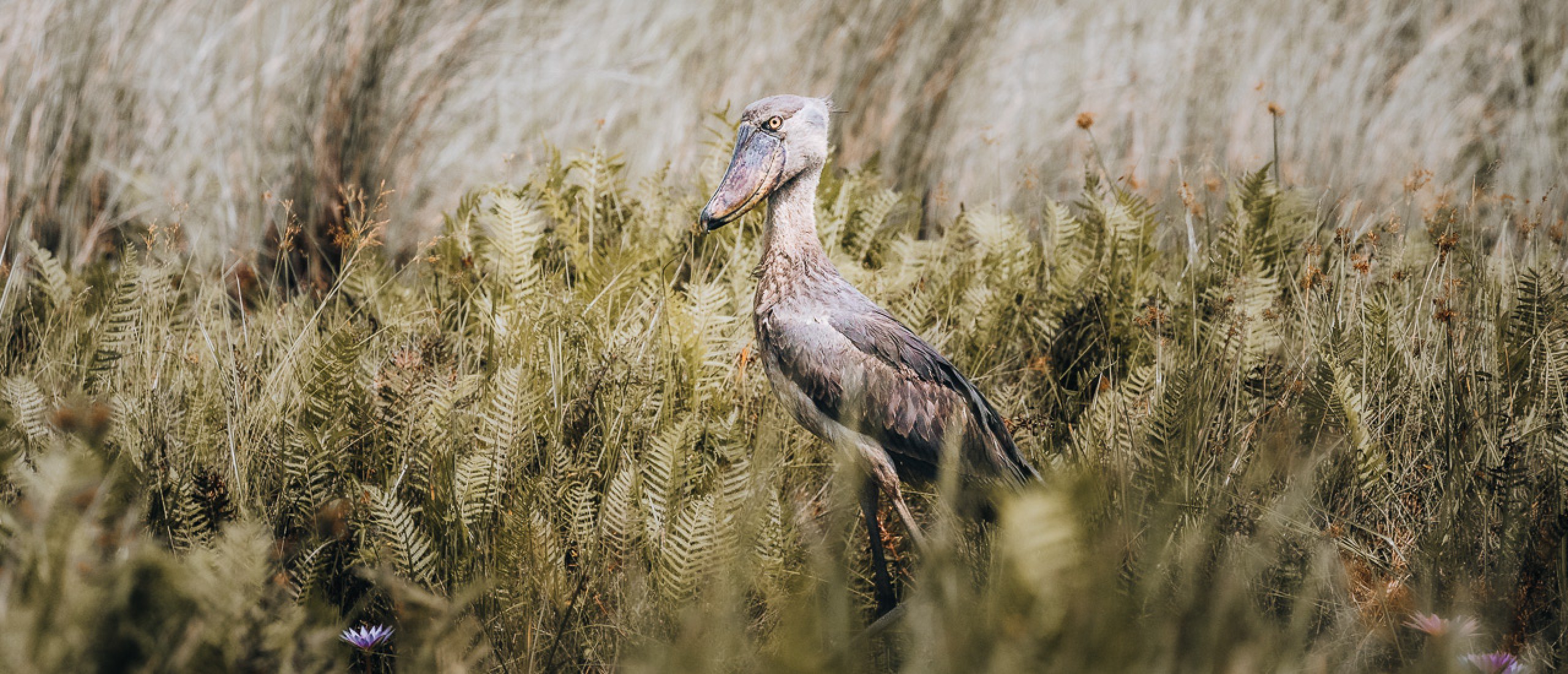
Shoebill Stork
The Shoebill (Balaeniceps rex) known as the Whale-headed stork or Shoe-billed stork, is a prehistoric-looking long-legged wading bird species native to Central and East Africa. Its distinct appearance, with a bill that looks like the shape of a shoe or a Dutch wooden clog, makes it a sought-after sight for bird lovers and wildlife photographers. The giant stork-like bird, is also referred to as ‘the king of the marshes’.
Here are some facts about the Shoebill:
Shoe-shaped bill
The Shoebill has a massive, shoe-shaped bill that gives it its name. The bill is thick, elongated, and broad, with sharp edges. Its color ranges from grayish to dull green, often with a yellowish or whitish tint.
Size of the Shoebill
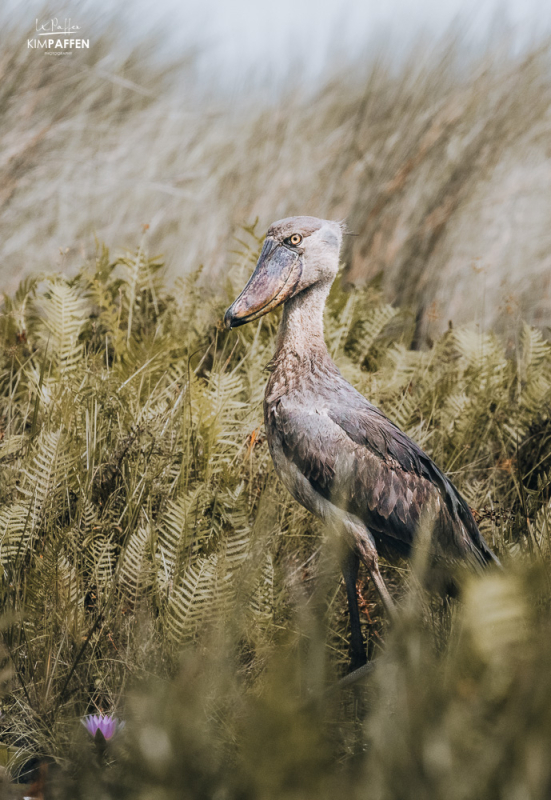
Shoebills are one of the largest bird species in Africa. They can reach a height of up to 1.2 to 1.5 meters (4 to 5 feet) and have a wingspan of about 2.3 meters (7.5 feet).
Weight of the Shoebill
Adult shoebills typically weigh between 4 to 7 kilograms (8.8 to 15.4 pounds).
Shoebills can fly!
The shoebill is capable of flying. Despite their large size and heavy appearance, shoebills are proficient fliers. They have strong wings and can cover considerable distances when in flight. While they may not be as agile in flight as smaller bird species, Shoebills are capable of traveling between different wetland habitats in search of food, nesting sites, or suitable breeding grounds.
Shoebills primarily rely on flight as a means of transportation rather than for extensive aerial displays or long-distance migratory journeys. They are generally sedentary birds that remain in or near their preferred wetland habitats for most of their lives.
Shoebill habitat

Shoebills are wetland dwellers primarily found in tropical swamps, marshes, and wetlands of Central and East Africa, including Uganda, Rwanda, South Sudan, Tanzania, and Zambia. They prefer habitats with shallow water, papyrus reeds, and abundant fish, which make up a significant portion of their diet. The Shoebill nests on papyrus platforms.
Feather Adaptations
The feathers of a shoebill play a crucial role in keeping the bird dry and maintaining its buoyancy while navigating through the wetland habitats. Their feathers have a unique structure that allows them to repel water and stay relatively dry, even in the swampy environments they inhabit.
Feeding behavior & diet of the Shoebill
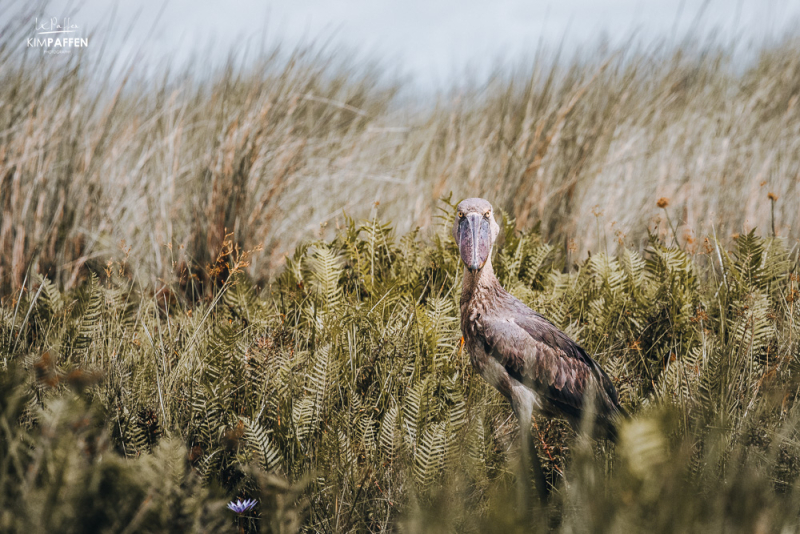
The shoebill is an apex predator and is well-adapted for catching and feeding on fish, its primary food source. It stands motionless for long periods. With lightning-fast reflexes, it lunges forward, snapping its bill shut with incredible force to capture its prey.
Lungfish
Fish form the main component of a shoebill's diet. They primarily target species that inhabit the shallow waters of swamps and wetlands where they live. The Shoebill stork are particularly known for their ability to capture lungfish. These prehistoric-looking fish can be quite large and have adapted to survive in oxygen-poor environments. The shoebill's bill is well-suited to handle lungfish due to its sharp edges and robust structure, allowing them to grasp and handle their slippery prey.
Frogs and reptiles
While fish are their primary food source, shoebills also consume other aquatic creatures, including frogs and small reptiles that reside in or around the water bodies they inhabit. So, when Shoebills eat reptiles, do they eat crocodiles? Yes, it's rare but Shoebills can eat baby nile crocodiles.
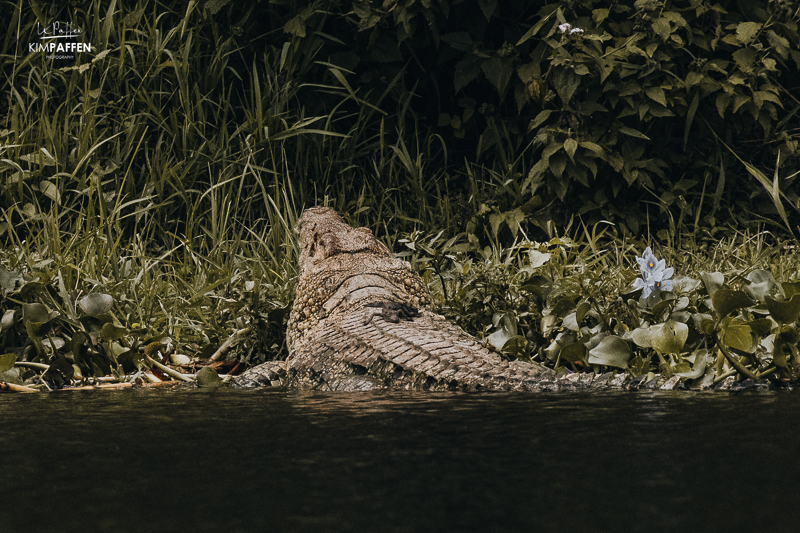
Birds and small mammals
Although less common, shoebills have been known to consume birds and small mammals. They may opportunistically prey on smaller bird species, such as waterfowl or chicks, as well as small mammals that venture near the water's edge.
The shoebill's diet can vary depending on the availability of prey species in their specific habitat. Their unique bill and hunting techniques make them formidable and successful hunters in their wetland environments.
Stealthy hunters
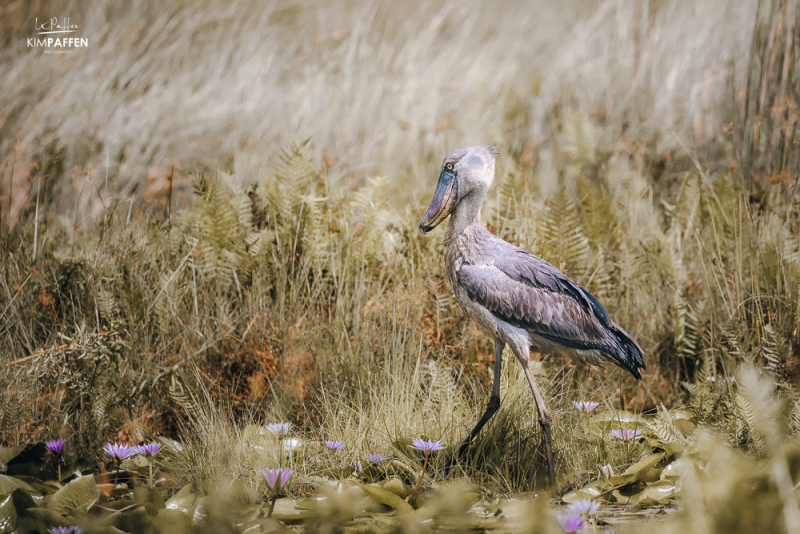
Shoebills are known for their stealthy hunting behavior. They often wade through shallow waters, moving slowly and silently, using their long legs and large webbed feet to navigate through the vegetation. This allows them to approach their prey without causing any disturbance.
Endangered status
The shoebill is classified as vulnerable on the IUCN Red List of Threatened Species. According to BirdLife International, there are only 3300-5300 mature Shoebills left in the wild. The main threats to their survival include habitat loss due to wetland degradation, human disturbance, and hunting. Conservation efforts are crucial to protect and preserve their habitats and ensure the long-term survival of this unique bird species.
Slow Reproductive Rate
Shoebills have a slow reproductive rate. They typically lay only one to three eggs per breeding season, and the breeding cycle is quite long. Incubation can last for approximately 30 to 40 days, and the chicks remain dependent on their parents for an extended period before becoming independent. Whenever a Shoebill lays two eggs, only one will make it to adulthood.
Apart from the slow reproductive rate, the rivalry between shoebill chicks is another reason why it’s difficult to raise more than one single shoebill chick to adulthood. Watch this short 4-minute video of the dark side of shoebill chicks narrated by David Attenborough for BBC Earth:
Unique breeding behavior
Shoebills are monogamous and typically breed during the dry season. They construct large nests made of sticks and vegetation in secluded areas of the swamp or on floating vegetation. The female usually lays a single egg, which both parents take turns incubating for about 30 to 40 days. The chick is cared for and fed by the parents until it becomes independent.
Nocturnal activity
Shoebills are primarily diurnal (active during the day), but they can also exhibit nocturnal behavior, especially during the breeding season. They may engage in activities such as courtship displays and vocalizations during the nighttime hours.
What sound does the Shoebill make?
Shoebills produce a variety of vocalizations, including deep, booming calls, croaking sounds, and bill-clattering noises that is referred to as the sound of a machine gun. These vocalizations are used for various purposes, such as communication, territorial displays, and courtship rituals.
Lifespan of a Shoebill: How old does it get?
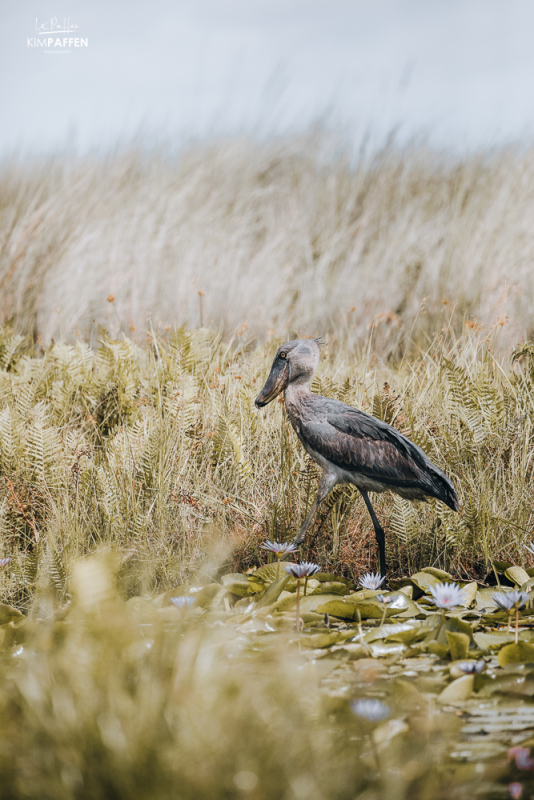
The estimated lifespan of a shoebill (Balaeniceps rex) in the wild (in their natural habitat) is approximately 35 to 50 years. These estimates are based on the lifespan of captive shoebills and similar bird species. Factors such as habitat quality, availability of food, predation, and human disturbances can influence how long shoebills can live.
In captivity, where they are provided with proper care and suitable conditions, shoebills have been known to live even longer, with some individuals reaching ages of 50 years or more.
Solitary nature
Shoebills are generally solitary birds, preferring to spend most of their time alone or in pairs. They are territorial and can exhibit aggressive behavior towards other shoebills that encroach upon their territory.
However, within their wetland habitats, shoebills may coexist with a variety of other bird species, including herons, storks, and waterfowl. While they may share similar foraging areas or nesting sites, their interactions are neutral or competitive rather than mutually beneficial.
Cultural significance
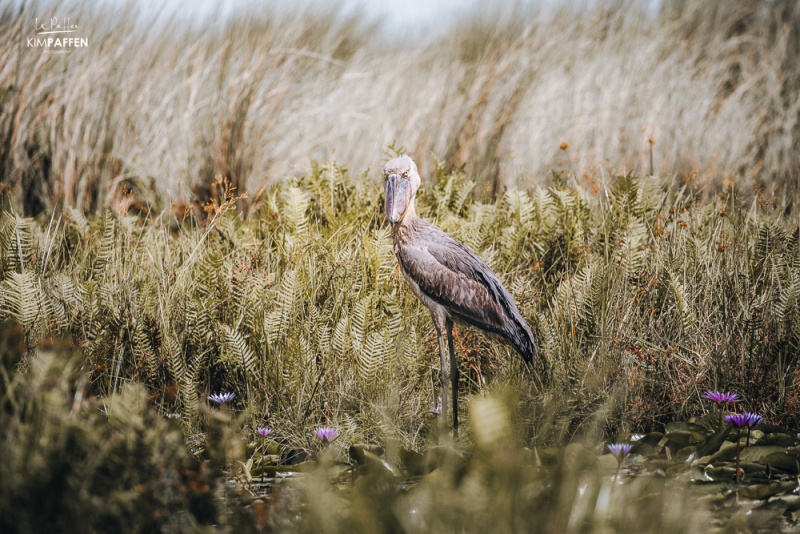
In some local cultures, the shoebill holds cultural significance and is considered a sacred bird. It is revered and protected, and its presence in certain areas is associated with good fortune and blessings. Examples of cultural significance of the Shoebill:
Buganda Kingdom, Uganda
The Buganda Kingdom, one of the largest traditional kingdoms in Uganda, holds the shoebill as a sacred bird. In Buganda culture, the shoebill is known as "Luwombo" and is considered a symbol of good fortune and protection. It is believed that the presence of a shoebill in the vicinity brings blessings and prosperity.
South Sudan
In South Sudan, in the Jur-Chol community, the Shoebill bird is regarded as a spirit animal and is associated with certain rituals and beliefs. It is considered a powerful and mystical creature, often associated with the spiritual realm.
Swahili Culture
Along the East African coast, particularly in areas influenced by Swahili culture, the Shoebill stork has cultural significance. It is sometimes associated with folklore and traditional beliefs, symbolizing wisdom, strength, and protection.
Is the Shoebill related to the dinosaur?
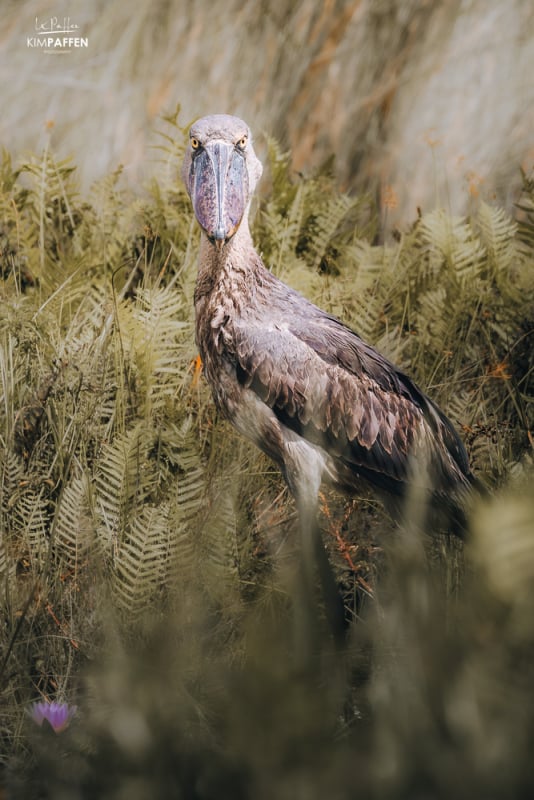
The shoebill is not directly related to dinosaurs. However, its looks are described as prehistoric or dinosaur-like. The resemblance to dinosaurs is primarily because of its large size, robust build, and distinctive bill shape, which resembles the beaks of certain ancient reptiles.
The shoebill belongs to the family Balaenicipitidae, which is a small family of birds. Its closest living relatives are believed to be the pelicans and herons, rather than dinosaurs. Various molecular studies, found the Shoebill to be a sister of the Hamerkop, meaning the Shoebill is a very close relative to the Hamerkop.
Is the Shoebill dangerous to humans?
Shoebills are generally not considered dangerous to humans. They are solitary and non-aggressive birds that prefer to keep their distance from human activity. When encountered, they typically try to avoid confrontation and will fly away if they feel threatened or disturbed.
However, like any wild animal, Shoebills may exhibit defensive behavior if they perceive a direct threat to themselves or their nests. If a person approaches too closely or invades their nesting territory, the shoebill may display warning behaviors such as bill-clattering, hissing, or lunging. It's important to respect their space and observe them from a safe distance to minimize any potential disturbances.
Additionally, shoebills have a powerful bill that they use for catching and consuming prey. While they are not known to attack humans, it is always advisable to maintain a respectful distance and not attempt to handle or provoke them.
Related Shoebill articles
I was fortunate enough to go Shoebill watching in Mabamba Swamp in Uganda, probably the best place to see the Shoebill.
Shoebill Safari & Tours
For a chance to see the enormous prehistoric-looking Shoebill hunt in the wild, here are a few Shoebill excursion deals.

